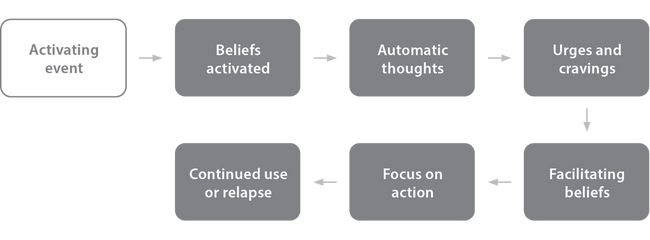Using CBT to Treat Substance Use Disorders
Paul Brasler offers up free CBT-based worksheets for working with clients with substance use disorders.

The model begins with an activating event, which can be a single event or a series of events, that trigger substance-related thoughts. This event can be innocuous and have nothing to do with substance use, but the key is that it begins the thinking process that could lead to substance use. For example, a clientãs spouse might muse, ãI could really use some time to myself right now.ã This activating event directly triggers the personãs initial beliefs, which are deeply engrained and typically skewed toward the negative. For example, after hearing their spouse request some time to themselves, the client may irrationally conclude, ãThey want time to themselves because Iãm a horrible partner,ã ãI always drive people away,ã or ãI am not worthy of being loved.ã
Our automatic thoughts flow directly from our beliefs, and we tend to be more aware of these thoughts when compared to our initial beliefs. These thoughts are often a reaction to our initial beliefs and may serve to relieve tension from those beliefs. Continuing with our example, the client might think, ãI just want to have a drinkã or ãIãm going to get high.ã Again, this may be the first part of the process that the client is consciously aware of, but itis still being driven by those initial beliefs.
As the client becomes aware of their thoughts, they begin to have physical cravings and emotional urges to engage in behaviors connected to what they are thinking about. The client may think about walking into a bar, imagine tasting alcohol, or obsess over feeling high, numb, or relaxed. These cravings and urges then lead to facilitating beliefs that encourage substance use. This is an important step in the model because it is where the client attempts to justify their urges and cravings. In our example, the clientãs facilitating belief might be ãYeah, I deserve a drink.ã The essence of CBT is to recognize this process and then try something different. The goal is to help the client to believe ãI know that using wonãt help meã or ãI know these urges and cravings wonãt last forever.ã
Once a client develops a facilitating belief, they begin to focus on action. For example, the person might call their dealer to purchase drugs or drive to the corner store to purchase alcohol. This then leads to continued use or a return to use. The hope is that clients do not get to this stage, as your work in CBT is to limit the opportunities for this to occur.
In order to intervene at each stage of the model and help clients address the problems that often precipitate their SUD, CBT targets five areas:
- Managing cravings: An important part of treatment involves helping clients understand that cravings are a substantial part of SUD. CBT can help them learn how to recognize cravings, how they experience cravings, and how to deal with their cravings.
- Avoiding high-risk situations: Another important part of recovery involves avoiding situations where substances are available, as well as staying away from emotionally charged interactions that could trigger use.
- Case management: The provision of case management helps clients connect with other services they may need that can support their journey toward recovery.
- Mood regulation: With CBT, clients develop a better understanding of their feelings and how these feelings impact their thoughts. It also helps them see how substances are often used to change how they think and feel, and this can help teach them how to regulate their feelings without substances.
- Lifestyle changes: SUD impacts the whole person, so treating SUD involves examining every aspect of a clientãs life, seeing all the things that impact their SUD, and making appropriate changes to support recovery.

With its strong emphasis on person-centered care, this book offers a refreshing approach for working alongside people with substance use disorders that humanizes the addiction crisis and shifts the focus to the person, not their diagnosis. Each chapter includes reproducible handouts, exercises, and assessment tools that walk readers through the stages of the therapeutic process, from intake and assessment to treatment planning and recovery.
Paul Brasler, MA, MSW, LCSW, became a Licensed Clinical Social Worker in 2002. He is the owner of Providence Consulting and Education, LLC, through which he provides clinical supervision and professional education services. Paul has extensive experience working with adults and adolescents living with substance use disorder and co-occurring disorders. He maintains a private practice and has worked in community mental health clinics, hospital emergency departments, a juvenile drug treatment court, ketamine-assisted psychotherapy, and adolescent residential treatment.
Paul has been a ¤Öêüë½ presenter since 2016, and he has presented classes on Mental Health Emergencies, High-Risk Clients, and substance use disorder treatment across the country. His first book, High Risk Clients: Evidence-Based Assessment & Clinical Tools to Recognize and Effectively Respond to Mental Health Crises (¤Öêüë½ Publishing), was published in August 2019. His second book, The Clinicianãs Guide to Substance Use Disorders: A Practical Guide to Assessment, Treatment & Recovery, was published in 2022 (¤Öêüë½ Publishing & Media).
Learn more about his educational products, including upcoming live seminars, by clicking here.




